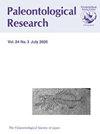印度戈达瓦里河腹足类动物放牧痕迹及其在化石记录中的保存潜力
IF 0.6
4区 地球科学
Q3 PALEONTOLOGY
引用次数: 0
摘要
摘要在印度哥达瓦里河(Godavari River)沿岸露出的二叠纪砂岩的侵蚀表面上,发现了被归为腹足类并被归类为早期Radulichnus的放牧痕迹,远远超出了海洋的影响。据推测,它们是在观测前大约四个月的季风洪水期间产生的,可能是由Ampullariidae科的苹果蜗牛Pila globosa (Swainson, 1822)以生物膜为食产生的。即使经过这么长的一段时间,它们的形态仍然保存得很好。这证明了它们的保存潜力,特别是当它们被沉积物掩埋时,也表明这些痕迹可以在古代河流环境中作为化石被发现。本文章由计算机程序翻译,如有差异,请以英文原文为准。
Gastropod Grazing Traces (Incipient Radulichnus isp.) in the Godavari River, India and their Preservation Potential in the Fossil Record
Abstract. Grazing traces attributed to gastropods and classified as incipient Radulichnus occur on eroded surfaces of Permian sandstones outcropping along the Godavari River in India, far beyond marine influences. Presumably, they were produced during monsoon flooding approximately four months before observations, probably by the apple snail Pila globosa (Swainson, 1822) of the family Ampullariidae feeding on biofilms. Even after such an extended period of time, their morphology is still well preserved. This demonstrates their preservation potential, especially when buried by sediment, and also suggests that such traces can be found as fossils in ancient fluvial environments.
求助全文
通过发布文献求助,成功后即可免费获取论文全文。
去求助
来源期刊

Paleontological Research
PALEONTOLOGY-
CiteScore
1.60
自引率
0.00%
发文量
47
审稿时长
>12 weeks
期刊介绍:
Paleonotological Research (PR) is a quarterly, peer-reviewed international journal, which focuses on original contributions primarily in the area of paleontology but also covering a wide range of allied sciences. It has been published since 1997 as a successor to the former journal Transactions and Proceedings of the Palaeontological Society of Japan. The emphasis of contributions will include global and local perspectives, and contents can cover all ages (Precambrian to the Quaternary, including the present time).
 求助内容:
求助内容: 应助结果提醒方式:
应助结果提醒方式:


